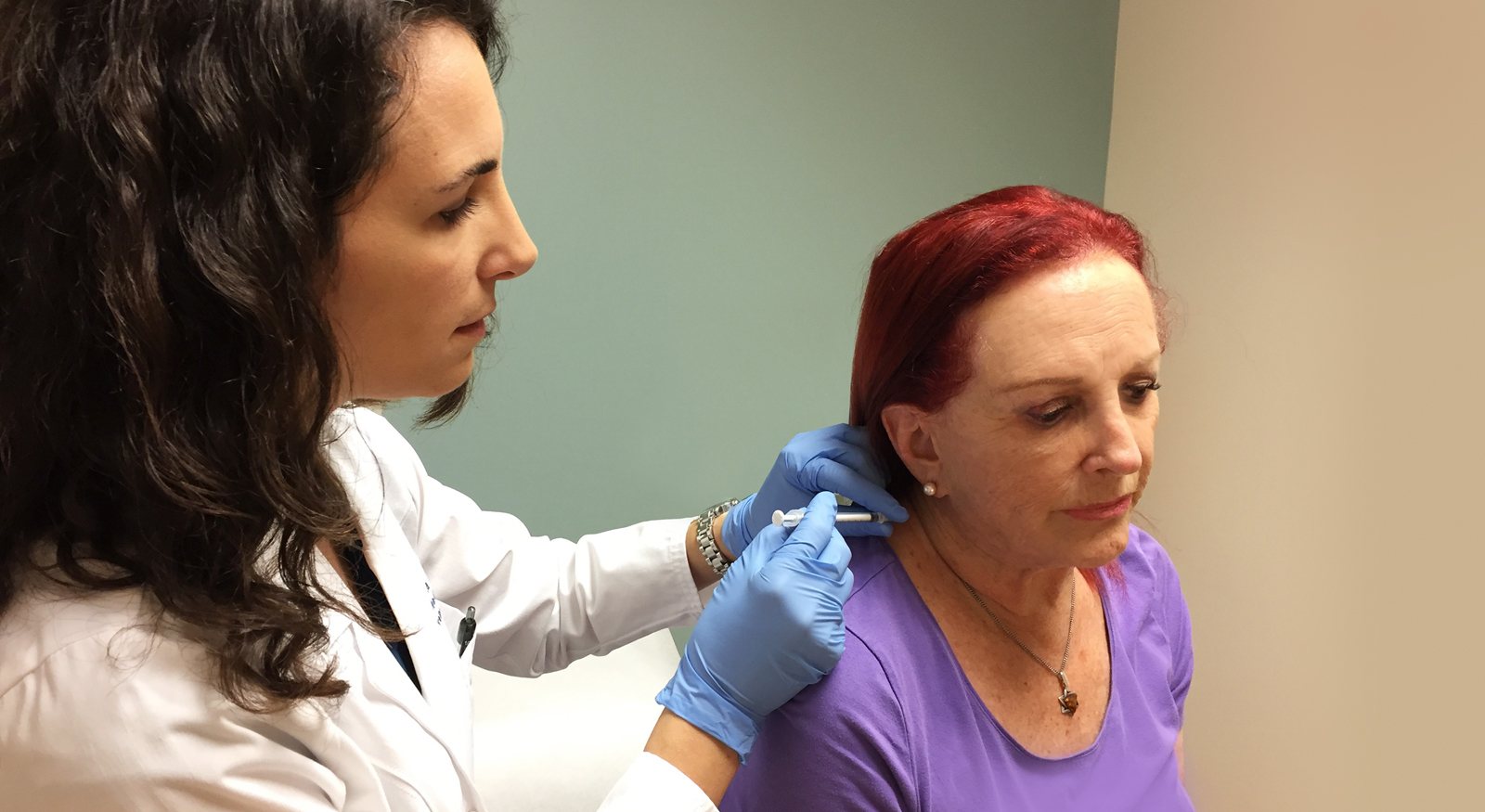
Cervical Dystonia
Cervical dystonia (sometimes called neck dystonia) is the abnormal position of the muscles of the neck, causing a twisted, turned, flexed or extended neck position.
Abnormal signals coming from the deep parts of the brain cause this condition and therefore it is not muscular in nature and will not resolve with muscle massage or stretching.

Symptoms
While it is relatively uncommon, cervical dystonia is by no means rare. Cervical dystonia often comes on in mid-life but can begin at any age, and typically affects women twice as frequently as men. It manifests as pain or discomfort in the neck. Patients often report that touching their head or face in a particular way can temporarily improve the position; this is known as a geste antagoniste or sensory trick. Stress may worsen dystonia and relaxation techniques can help somewhat.
Patient unfamiliarity is expected and common but unfortunately physician lack of recognition is an issue as well. About half of patients with cervical dystonia complain of neck pain, so patients and physicians often think of the more common causes of neck pain such as musculoskeletal strain or cervical radiculopathy (pinched nerve).
In addition to neck pain, many patients may manifest with a isolated head tremor (meaning tremor involving the head and neck and not involving the arms or legs). Tremor in cervical dystonia tends to be jerky and irregular, and often is worse in the direction of the head away from the abnormal positioning. So, if cervical dystonia is causing a head turn to the right, tremor may be worst when the patient attempts to turn their head to the left.
Diagnosis
Typically, cervical dystonia is diagnosed based on the clinical exam. The Toronto Western Spasmodic Torticollis Rating Scale (TWSTRS), is a highly specialized rating scale used to precisely define the type and severity of cervical dystonia, typically with a video documentation after obtaining patient consent. In cases of dystonia involving other body parts in addition to the neck, further evaluation may be necessary to exclude other causes of dystonia. Genetic causes of dystonia are probably more common than we can currently assess for — specific genetic syndromes include DYT 1 generalized dystonia, dopa-responsive dystonia, and rapid onset dystonia-parkinsonism. In patients with young-onset dystonia, especially if there is involvement of the lower extremities and improvement after sleep, a levodopa trial is warranted where a dramatic response to levodopa would be expected if the diagnosis is dopa-responsive dystonia (aka Segawa syndrome). In some cases an MRI of the brain and blood or urine tests may be advised to exclude any other causes of adult-onset idiopathic (primary) cervical dystonia.
Treatment
The mainstay of treatment of cervical dystonia is with injection of botulinum toxin, such as Botox or Xeomin. Botulinum toxin injections work by causing a disruption between the nerve and the muscle, thereby weakening the muscle that it is injected into. For cervical dystonia, because the muscles that are pulling or twisting the neck to one side are overactive, Botox works to calm those specific muscles down and allows for a more natural and neutral head position.
EMG guidance during Botox injections is used to verify muscle activity. 100 to 300 units are injected divided into 4 to 12 injections at a time. The entire procedure takes about 20-30 minutes in the clinic. Botox takes about 3-7 days after injection to show activity, and the duration of effect lasts about 10-14 weeks. Most patients return every 12 weeks for repeat injection. Side effects typically occur due to spread of the toxin to other muscles, and may include neck weakness, trouble holding the head up, neck pain, swallowing difficulty, and rarely slurred speech, but resolve as the medication’s effect wears off.
In some patients, botulinum toxin injections are not sufficient to control the symptoms, and oral medications may be useful as additional treatment.These include benzodiazepines such as clonazepam, anticholinergics such as trihexiphenidyl, and muscle relaxants such as baclofen. All of these medications can be associated with muscle weakness, somnolence (sleepiness), dizziness, imbalance, and fogginess. In addition, trihexiphenidyl can cause dry mouth, nausea, constipation, urinary retention (inability to urinate) and confusion. Therefore, these oral medications are not considered first line over botulinum toxin injection.
Patients whose dystonia does not respond to botulinum toxin injection may be good candidates for deep brain stimulation surgery (DBS) for dystonia. DBS is like a pacemaker for the brain and results in non-permanent suppression of a deep part of the brain.
